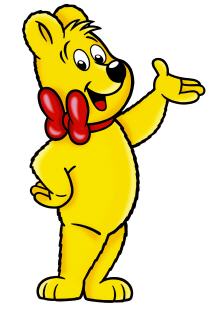

Haribo vs. Lindt – Lindt’s golden chocolate bear does not infringe Haribo’s trade mark rights
October 07, 2015
Categories:
Post date:
7. October 2015 - 12:41
The German Federal Court of Justice (BGH) ruled that one must be strict when comparing a word mark with a three-dimensional mark in order to prevent right owners from monopolizing product shapes by obtaining word mark protection. The BGH concludes that Lindt and Sprüngli AG is not infringing Haribo’s trade mark rights when selling a seated golden chocolate teddy bear with a red ribbon. (Case I ZR 105/14, Judgement of 23 September 2015)
Press here to read our earlier blog post about the decision from the Higher Regional Court of Cologne.
Word mark and two-dimensional device mark vs. three- dimensional trade mark
Background of the case and subject matter
The applicant, Haribo, is a well-known German company which produces and sells fruit gum products. Haribo is especially known for its gummi bears and has obtained various German trade mark rights for these, e.g. “Goldbären” (DE 974 380) , “Gold-Teddy” (DE 302 011 030 914) and “Goldbär” (DE 39,922,430). “Goldbär” is also registered as a word/device Community Trade Mark (CMT 009423757).
The defendant, Lindt and Sprüngli AG, is a well-known Swiss company which produces and sells chocolate products. Since 2011, Lindt has sold a chocolate figure around Christmas in the shape of a seated bear, rapped in golden foil and with a red ribbon around its neck. This chocolate bear is called the “Lindt Teddy”. In 2012, Lindt filed an application for registration of its three-dimensional trade mark of the “Lindt Teddy” in Germany (Reg. number 1125991). Haribo is of the opinion that Lindt’s chocolate teddy infringes its trade mark rights and constitutes an unfair imitation of the “Goldbären”.
On 18 December 2012, the Regional Court of Cologne rendered a decision that there is a likelihood of confusion between the “Lindt Teddy” and the “Haribo Goldbär”. They focused, in particular, on the fact that both companies are in the same industrial sector, that the Goldbär enjoys a high degree of reputation and that among the Christmas products, only Lindt’s teddy chocolate has the same form, golden colour and red ribbon as the Goldbär.
Lindt appealed the Regional Court’s decision. On 11 April 2014, the Higher Regional Court of Cologne overturned the Regional Court’s decision.
The Higher Regional Court stated that too much emphasis had been put on the colour and shape of the bear in the previous decision. The focus should rather be on the product as a whole and how customers perceive it. The Higher Regional Court pointed out that the well-known name “Lindt” is located in the middle of the chocolate teddy, indicating the commercial origin of the product. Furthermore, also “Lindt” is a very famous brand and the Christmas teddy is in consistency with the successful Easter chocolate rabbit Lindt sells around Easter time. Thus, the Higher Regional Court neither found a likelihood of confusion, nor the existence of unfair competition.
The decision of the Higher Regional Court was appealed to the BGH. An interesting question arising in this case is whether pure word marks can be infringed by three dimensional trade marks.
The Decision of the German Federal Court of Justice (BGH)
The BGH upheld the Higher Regional Court of Cologne’s decision and rejected Haribo’s infringement action. They admitted that Haribo’s word marks are well-known in Germany and that the goods in question are highly similar.
However, the BGH says that when comparing a word mark with a three-dimensional mark, confusion can only arise from conceptual similarities. It is further stated that there is only a danger of confusion when the word mark is the only and obvious reference perceived by the customers when seeing the three-dimensional product shape. The BGH emphasizes that one must be strict when carrying out this test in order to prevent right owners from monopolizing product shapes by obtaining word mark protection and thus detouring around the stricter requirements for registration of device marks and three-dimensional product shape marks. The BGH ruled out the danger of confusion of association between Haribo’s word marks and the trade dress of Lindt’s chocolate teddies.
The infringement action was also rejected in regards to unfair competition law. Firstly, there is a lack of similarity between the device mark showing a standing bear and the Lindt Teddy (shown above). Furthermore, Haribo only registered the “Gold Teddy” mark after it had obtained knowledge of Lindt’s intention to sell a chocolate teddy bear. The BGH also found that Lindt’s chocolate bear shape is not sufficiently similar to Haribo’s fruit gum shape.
Press here to read the BGH’s press release in German.
Related
- "Neuschwanstein" is not a trademark!
- 1 December 2017: Madrid Monitor takes its place as the one and only tool for tracking international trademarks
- 1 January 2020 - Changes in Classifications - Trademarks, Designs, Patents and Utility Models
- 100th Anniversary of Bavaria (Germany) - A glance at trademarks, start-ups, innovation & events
- 10th Anniversary Edition - 10 Things to Know about LexDellmeier - Past, Present & Future
- 14 June 2013: Munich Patent Law Conference - Calculating Damages in Patent Infringement Cases
- 15 Top Brands - Interactive Brand Rating - Years 2000 - 2018
- 15 Years LexDellmeier - 2024 New Year Wishes
- 2014: Statistics for Community Trademarks
- 2024 World IP Day - Building Our Common Future with Innovation and Creativity

